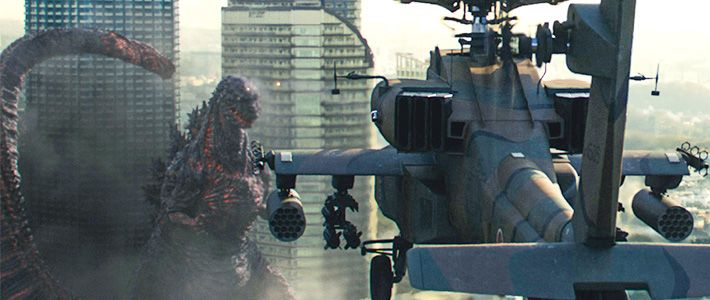
The Tokusatsu Entertainment Genre that Godzilla Spawned
Resurgent Godzilla Back to Trample Tokyo
Culture- English
- 日本語
- 简体字
- 繁體字
- Français
- Español
- العربية
- Русский
In 2014, Nippon.com interviewed Watanabe Ken, the star at the heart of Godzilla, Gareth Edwards’ high-tech Hollywood take on Japan’s legendary marauding monster. Watanabe spoke of the frustration he felt at the Japanese film industry—the subject of Godzilla was more relevant than ever to Japan, he said, but its filmmakers had let a golden opportunity pass into the hands of Hollywood. Two years later, that situation is about to be rectified. This summer, a Japanese Godzilla returns to the screens at last—12 years after the last installment.
Shin Gojira (Godzilla Resurgence), released in Japan on July 29, is the work of two of the best-known figures in Japanese action filmmaking. Anno Hideaki, whose science fiction anime series Neon Genesis Evangelion is beloved by fans around the world, wrote the screenplay and worked as chief director. Alongside him was Attack on Titan director Higuchi Shinji.
From the original eponymous movie in 1954 to Godzilla: Final Wars in 2004, Tōhō film studios released a total of 28 Godzilla movies. It then set its most famous property aside for over a decade. In an age when most commentators agree that the Japanese film industry cannot compete with Hollywood when it comes to computer graphics and other visual effects, what makes this the ideal moment for a new Japanese Godzilla?
Godzilla Comes Home
We spoke to Godzilla Resurgence producer Yamauchi Akihiro, asking him when the project began. “The concept goes back to around 2012, I guess. I pitched the idea to Anno Hideaki at the start of 2013. The situation today is different from when a new Godzilla came out almost every year. This was going to be the first Godzilla film made in Japan for 12 years, so it was important to make sure the right director was on board from the start. Anno-san was the ideal choice. Evangelion has a huge fan base all over the world, and he knows everything there is to know about Japan’s special effects industry.”
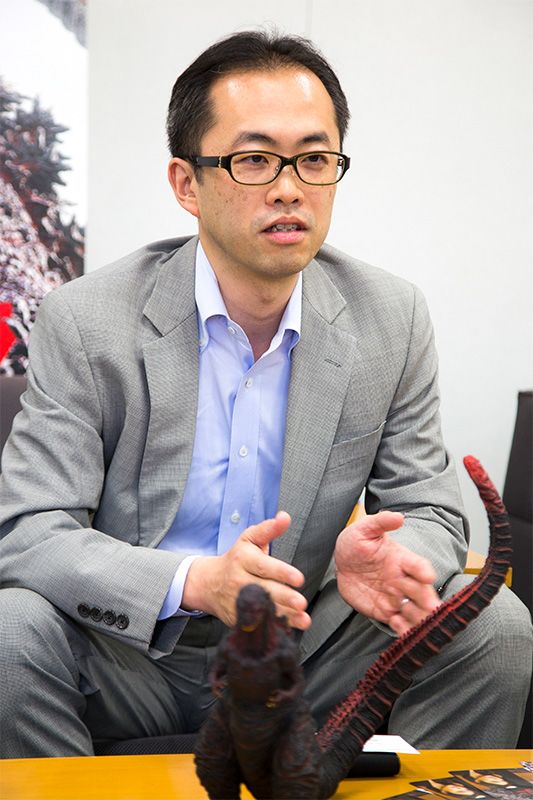 Producer Yamauchi Akihiro says he wanted to create a Godzilla that reflected the anxieties of contemporary Japan.
Producer Yamauchi Akihiro says he wanted to create a Godzilla that reflected the anxieties of contemporary Japan.
Yamauchi says he has nothing against the idea of a Hollywood Godzilla. In fact, he thought Gareth Edwards’s movie did a good job of balancing the need for action against the more menacing aspects of a monster movie haunted by the terror of nuclear destruction. “It was obviously made by someone with a real love for the Godzilla movies,” he says. But a Japanese studio, he suggests, is able to take a different approach from what’s possible in Hollywood, where movies are premised on worldwide marketing. “Hollywood has to look to the global market, but our situation is different. The first priority for us is the audience in Japan. In a way this movie is our response to Hollywood—an attempt to show the world what Godzilla means for Japan today.”
The monster’s awesome destructive power is an essential part of the Godzilla legend, present in one form or another in every version of the story, often in ways that reflect the concerns of the times. Anno’s script for the new movie is no exception. In the original 1954 film, Godzilla was a mutant child of the nuclear age, and a terrifying symbol of the destruction of war. The new Godzilla reflects the fears and anxieties of our own era, and is deeply marked by the ongoing trauma of the March 2011 tsunami and the ensuing nuclear crisis in Fukushima. “I think the experience of that disaster changed Japan more than anything else in the past 12 years. Escaping into fantasy would have been one option, I suppose, but Anno-san and I talked it over and we both agreed that an approach like that would be meaningless.”
 At a terrifying 118.5 meters tall, the new Godzilla is a more awe-inspiring presence than ever.
At a terrifying 118.5 meters tall, the new Godzilla is a more awe-inspiring presence than ever.
The Enduring Inspirational Power of a Classic
Anno agreed to put work on a new Evangelion theatrical adaptation on hold and dedicate himself to work on the Godzilla picture. Perhaps unsurprisingly, he says that one thing loomed in the mind more than anything else as he got to work on the project—the gargantuan shadow of that first epoch-defining Godzilla from 1954, still a powerful presence in the popular imagination more than 60 years later.
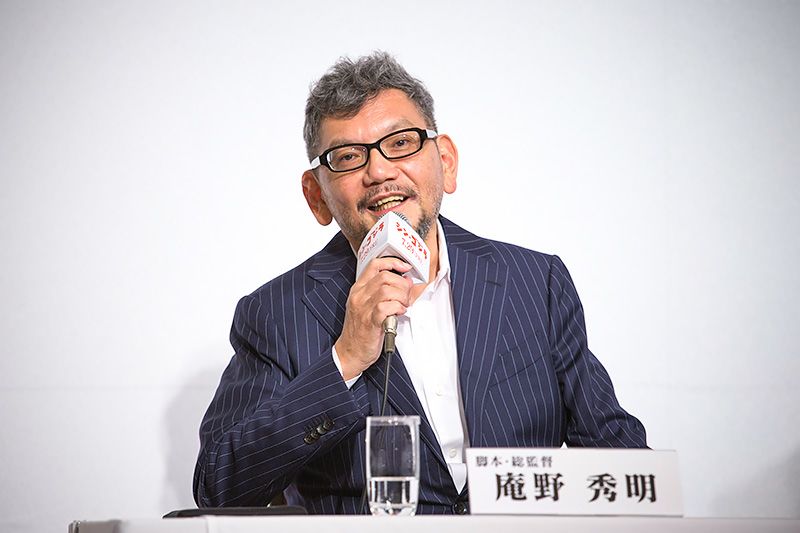 As chief director, Anno Hideaki said he wanted to get as close as possible to the shock unleashed by the original Godzilla.
As chief director, Anno Hideaki said he wanted to get as close as possible to the shock unleashed by the original Godzilla.
“I think that the first Godzilla movie encapsulates everything that makes monster movies so wonderful. It’s the standard that every other movie in the genre aspires to,” Anno said at a July 19 press conference. So great is his admiration for the original that at first he turned down Tōhō’s offer to direct the new film, believing the world already had its perfect Godzilla picture and there was nothing new he could bring to the story. Eventually he agreed to take the project on, attracted by the challenge of trying to echo the impact of the original masterpiece with a movie of his own.
“One of the things that makes these movies fun is the thrill we get when we see something monstrous appear in the middle of our familiar surroundings. It’s a vision of the world that can only be brought to the screen with special effects,” said Anno. Unlike in an anime, where everything on screen is make-believe, he says, “With special effects in a movie, you’re mixing imaginary elements in with actual images of the real world. That's what makes special effects work so much fun.”
In order to maximize that fun, the team decided that their film would not take the form of a sequel to any of the many Godzilla movies that had come before. Instead, the story is set in a contemporary Japan where Godzilla is making his terrifying appearance for the very first time. “I couldn’t think of any other way of getting close to what makes the impact of the original film so special,” Anno explained. “I knew we had to start from the beginning, and go back to a world without monsters. And then everything changes when Godzilla appears for the first time.”
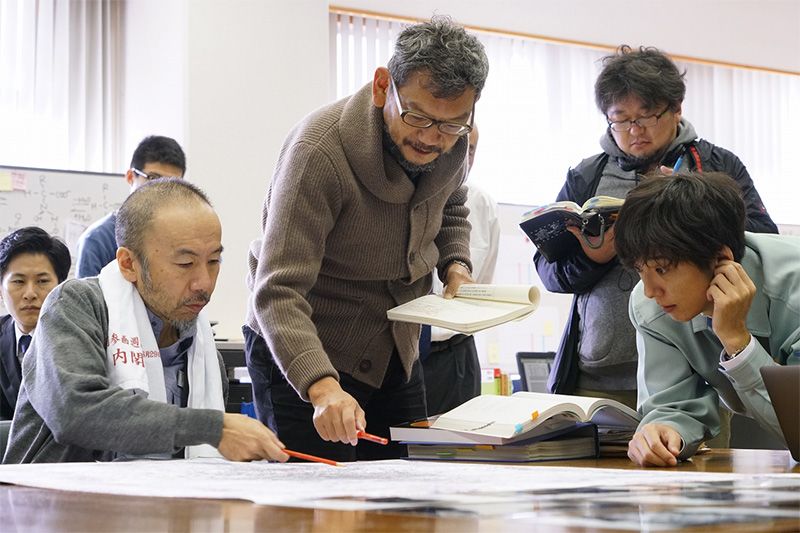 Anno (center) and Higuchi (second from right) direct Tsukamoto Shinya (left) and Takahashi Issei (right), who play two members of the government-led team in the fight against Godzilla.
Anno (center) and Higuchi (second from right) direct Tsukamoto Shinya (left) and Takahashi Issei (right), who play two members of the government-led team in the fight against Godzilla.
More Realistic Than Ever
One thing that gives the new Godzilla movie a different feel from its predecessors is the decision by the production team to make the details of the scenario as realistic as possible.
First, Godzilla himself. The main priority for the special effects team was to create an impression of Godzilla as a living, breathing animal presence. As well as giving the monster all the distinctive features that make him immediately identifiable to audiences around the world, Anno and Higuchi spent long hours with their two support staff putting all their passion and know-how into coming up with a new version of Gozilla, incorporating new elements into a real model of the monster until they came up with a vision that satisfied them.
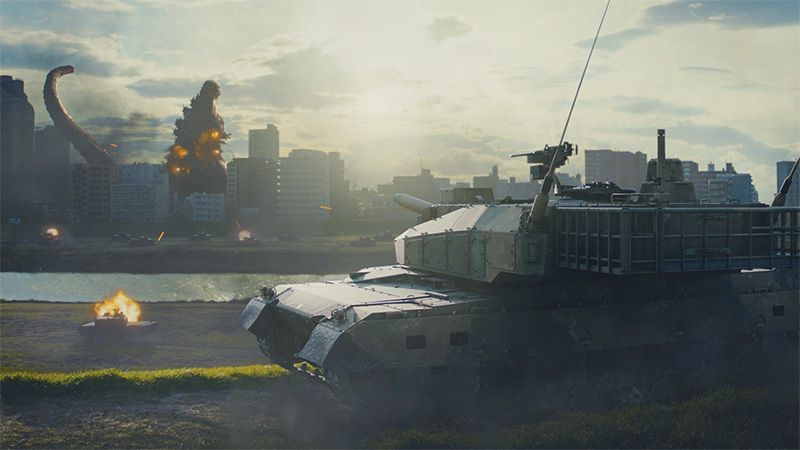 Japan’s Self-Defense Forces fight back against the monster. The SDF’s strategy is based on painstaking simulations of what might really happen in a crisis situation.
Japan’s Self-Defense Forces fight back against the monster. The SDF’s strategy is based on painstaking simulations of what might really happen in a crisis situation.
The new Godzilla reaches a height of 118.5 meters, making him loom far above many of the city’s skyscrapers. This is more than double the size of the first original Godzilla. “We considered whether he would be able to support his own weight at that size, and eventually decided that it would be impossible for him to walk on two legs, so his tail naturally had to get thicker and longer,” Yamauchi explains.
The creature unleashes his awesome destructive power against the shining metropolis of twenty-first century Tokyo, reducing much of the city center to rubble and mercilessly flattening Kasumigaseki and Nagatachō, the centers of government power, along with nearby Toranomon, recently the center of much glitzy rebuilding.
And this time, there are no special weapons or superpowers to help the desperate citizenry in their battle with the monster, like the “Super X” aerial vehicle that featured in the 1984 film Return of Godzilla. “This movie is all about being as realistic as possible. As director, Anno-san even talked to people in Japan’s Self-Defense Forces to get an idea of how they might set about reacting in this kind of emergency. So the movie depicts how the SDF would actually respond to an emergency situation of this kind, as far as we can tell, and the kinds of tactics they would use to attack the creature. Godzilla himself is imaginary, of course—but everything else is as realistic as we could possibly make it.”
Analog Effects or CG?
In bringing their new version of the Godzilla legend to life, Anno and Higuchi at first wanted to use Japan’s beloved tokusatsu special effects tradition to create the monster. Tokusatsu is largely an analog tradition that eschews high-tech wizardry in favor of miniature sets and actors dressed in monster suits.
When work on the production began, the film-makers at first tried a kind of hybrid, attempting to combine the latest computer graphics with the fuzzy down-to-earth appeal of the tokusatsu tradition. Eventually, though, they decided to rely entirely on computer graphics—a first for a Godzilla film made in Japan.
Anno explained: “Actors in costumes have their good points too. But we decided that computer graphics simply made a better fit with the esthetics and look we had in mind for the film. We wanted to use the distancing qualities of computer graphics to bring out the monstrous, non-human nature of our Godzilla. This is a Godzilla that has been stripped of any hint of human will.”
Anno said he paid special attention to the monster’s eyes. “There’s no emotion in his eyes, but I did take special care with his perspective and line of vision, and worked hard to get that just right. The scale of his body is so huge it’s almost in another dimension. But his eyes are looking down, peering at the people far below him. You could say this is the only communication that takes place between people and Godzilla in the movie.”
 Meeting the press. From left: Director Anno Hideaki with actors Ishihara Satomi (who plays the part of the US president’s special envoy, Kayoko Anne Patterson), Hasegawa Hiroki (Deputy Chief Cabinet Secretary Yaguchi Randō), and Takenouchi Yutaka (Special Advisor to the Prime Minister Akasaka Hideki)
Meeting the press. From left: Director Anno Hideaki with actors Ishihara Satomi (who plays the part of the US president’s special envoy, Kayoko Anne Patterson), Hasegawa Hiroki (Deputy Chief Cabinet Secretary Yaguchi Randō), and Takenouchi Yutaka (Special Advisor to the Prime Minister Akasaka Hideki)
Not Your Usual Action Movie Heroes
Another novel aspect of the latest Godzilla are the human characters who lead the fight against the monster. The film features none of the ordinary citizens who normally appear to save the day in action movies. “No stereotypical heroes: that was an important part of the director’s vision for the movie,” says Yamauchi.
“Normally in this kind of movie there is some kind of average person who is plucked out of the crowd to save the world in its moment of need. Scientists, professors, newspaper journalists, whatever. But in this movie it’s government bureaucrats who do all the work. That’s something new!”
After the Tōhoku disaster in 2011, the government came in for serious criticism for its sometimes bumbling response to the crisis at the crippled Fukushima Daiichi Nuclear Power Plant. But Anno felt sure that many government workers behind the scenes were doing their best in difficult circumstances, making logical decisions and taking the steps necessary to prevent a bad situation from getting even worse.
Despite all the work that went into making the scenario as realistic as possible,Godzilla Resurgence is first and foremost an entertainment movie. Yamauchi explains: “How will people in Japan deal with the various anxieties and insecurities facing them in the years to come? I think it would be difficult to keep people entertained for a two-hour movie on that subject without Godzilla. The character is one of the treasures of our popular culture. What we’ve tried to do on this film is to use that cultural resource to depict symbolically the anxieties besetting Japan today, and hopefully in the process come up with a story that will give people something to think about as well as keeping them entertained.”
No Easy Solutions
Eventually, the team of battling humans succeeds in finding a solution that will bring them at least temporary reprieve from the crisis. “Normally the movies end in one of two ways. Either the people finally succeed in defeating Gozilla, the way they do in the original film, or they find some way of persuading him to disappear back into the sea. This is the first time a movie has explicitly presented a solution that comes with a proviso—it’s never going to be more than a temporary solution. I think it’s an ending that suits today’s Japan perfectly. Accepting that there are no perfect solutions and learning to deal with stop-gap measures is a big part of our modern life, after all,” says Yamauchi.
Although the production team say their first priority when making the film was Japanese audiences, the movie has already attracted a huge amount of attention from overseas. By July, distribution rights had already been agreed for 100 territories around the world—beating the previous record for a made-in-Japan Godzilla, set by Godzilla: Final Wars, which was shown in 67 countries and regions in 2004.
The makers of the new Godzilla have tried to capture a slice of contemporary Japanese life in their new film. It will be fascinating to see how audiences around the world react to this latest rampaging take on Japan’s most fearsome—and beloved—monster.
(Originally written in Japanese and published on June 28, 2016. Banner photo © 2016 Toho Co., Ltd.)